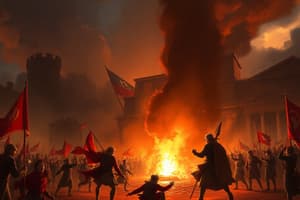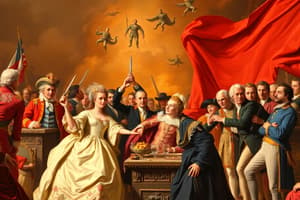Podcast
Questions and Answers
What was a major factor that contributed to the Parisian 'Reveillon riots' in April 1789?
What was a major factor that contributed to the Parisian 'Reveillon riots' in April 1789?
- Lack of access to healthcare
- Political instability
- Religious persecution
- High bread prices (correct)
What was the significance of Necker's dismissal in June 1789?
What was the significance of Necker's dismissal in June 1789?
- It led to the formation of the National Assembly.
- It increased fear among Parisians about a potential plot against them. (correct)
- It sparked a mass uprising against the monarchy.
- It caused a surge in bread prices.
What is the primary symbol of Royal Despotism that was stormed on July 14th, 1789?
What is the primary symbol of Royal Despotism that was stormed on July 14th, 1789?
- The Bastille (correct)
- The National Assembly
- The Louvre
- The Palace of Versailles
What was the primary reason for the withdrawal of royal troops from Paris in July 1789?
What was the primary reason for the withdrawal of royal troops from Paris in July 1789?
Who were the 'Sans Culottes'?
Who were the 'Sans Culottes'?
What was the primary goal of the Constituent Assembly?
What was the primary goal of the Constituent Assembly?
What was the main challenge faced by the Constituent Assembly in creating a constitution?
What was the main challenge faced by the Constituent Assembly in creating a constitution?
Which of the following was NOT an implication of the rejection of privilege as a principle for organizing society?
Which of the following was NOT an implication of the rejection of privilege as a principle for organizing society?
What was the primary cause of the 'Grand Peur' or Great Fear of late July 1789?
What was the primary cause of the 'Grand Peur' or Great Fear of late July 1789?
What was the purpose of Assignats?
What was the purpose of Assignats?
What was the main impact of the abolition of feudalism on 4th August 1789?
What was the main impact of the abolition of feudalism on 4th August 1789?
What was the primary cause of the Vendean Rebellion?
What was the primary cause of the Vendean Rebellion?
What was the 'Breton Club'?
What was the 'Breton Club'?
What strategic advantage did the Vendean rebels have?
What strategic advantage did the Vendean rebels have?
What distinguishes the Chouannerie from the Vendean Rebellion?
What distinguishes the Chouannerie from the Vendean Rebellion?
What was the main reason the Assembly acted quickly to abolish feudalism?
What was the main reason the Assembly acted quickly to abolish feudalism?
What was the driving force behind the opposition to the Revolution in Marseilles?
What was the driving force behind the opposition to the Revolution in Marseilles?
What was the corvee?
What was the corvee?
What is the significance of the term 'Federalism' as used in the context of the French Revolution?
What is the significance of the term 'Federalism' as used in the context of the French Revolution?
What did the Constituent Assembly decide to do about the rights and privileges that had been purchased by individuals?
What did the Constituent Assembly decide to do about the rights and privileges that had been purchased by individuals?
Which of the following was NOT a right or privilege abolished on August 4, 1789?
Which of the following was NOT a right or privilege abolished on August 4, 1789?
What was the major concern of the people of Lyon regarding the Convention's actions?
What was the major concern of the people of Lyon regarding the Convention's actions?
What was the primary difference between the provincial resistance in Marseilles and Lyon?
What was the primary difference between the provincial resistance in Marseilles and Lyon?
What can be inferred about the French Revolution from the events described in the text?
What can be inferred about the French Revolution from the events described in the text?
Which of the following groups played a significant role in fomenting popular unrest during the French Revolution?
Which of the following groups played a significant role in fomenting popular unrest during the French Revolution?
What was the primary reason behind the demonstrations that took place in Paris during the French Revolution?
What was the primary reason behind the demonstrations that took place in Paris during the French Revolution?
Which of the following was a significant difference between the Montagnards and Girondins?
Which of the following was a significant difference between the Montagnards and Girondins?
What key measure did the Montagnards take to try and address the concerns of the Sans-culottes?
What key measure did the Montagnards take to try and address the concerns of the Sans-culottes?
Which of these figures is known for his role in inciting demonstrations against the Convention?
Which of these figures is known for his role in inciting demonstrations against the Convention?
What was the “Pere Duchesne”?
What was the “Pere Duchesne”?
How did the actions of the Montagnards and Girondins differ in relation to the Revolution?
How did the actions of the Montagnards and Girondins differ in relation to the Revolution?
Which of the following is NOT a reason for the increasing tensions between the Montagnards and Girondins during the French Revolution?
Which of the following is NOT a reason for the increasing tensions between the Montagnards and Girondins during the French Revolution?
Which political figure was initially a proponent of defending the constitution, but later advocated for direct action against the Legislative Assembly and the King?
Which political figure was initially a proponent of defending the constitution, but later advocated for direct action against the Legislative Assembly and the King?
When was the Central Committee of the Sections established?
When was the Central Committee of the Sections established?
Which of the following figures was appointed to the surveillance committee of the insurrectionary Commune?
Which of the following figures was appointed to the surveillance committee of the insurrectionary Commune?
What was the main reason for the establishment of the insurrectionary Commune on August 9th, 1792?
What was the main reason for the establishment of the insurrectionary Commune on August 9th, 1792?
What was the primary source of tension between the Sans Culottes and the more established bourgeois politicians?
What was the primary source of tension between the Sans Culottes and the more established bourgeois politicians?
Which political group initially took the lead in responding to internal and external opposition to the Revolution but later became more conservative?
Which political group initially took the lead in responding to internal and external opposition to the Revolution but later became more conservative?
What is the main argument presented in the excerpt?
What is the main argument presented in the excerpt?
What was the primary reason for the split within the bourgeois elements that had initially supported the Revolution?
What was the primary reason for the split within the bourgeois elements that had initially supported the Revolution?
What was the primary reason for the centralisation of authority under the Committee of Public Safety?
What was the primary reason for the centralisation of authority under the Committee of Public Safety?
What was the purpose of the Decree Constituting Revolutionary Government in December 1793?
What was the purpose of the Decree Constituting Revolutionary Government in December 1793?
What was the impact of the centralisation of the Terror on the French economy?
What was the impact of the centralisation of the Terror on the French economy?
What was the primary objective of the Subsistence Committee established in November 1793?
What was the primary objective of the Subsistence Committee established in November 1793?
What was the significance of the rise in the value of Assignats between August and December 1793?
What was the significance of the rise in the value of Assignats between August and December 1793?
How did the confiscation of the goods of Revolution's opponents contribute to the appeasement of the sans culottes?
How did the confiscation of the goods of Revolution's opponents contribute to the appeasement of the sans culottes?
What did Robespierre's cooperation with Camille Desmoulins against Hebert and Chaumette reveal about the dynamics within the Committee of Public Safety?
What did Robespierre's cooperation with Camille Desmoulins against Hebert and Chaumette reveal about the dynamics within the Committee of Public Safety?
How did the centralisation of authority under the Committee of Public Safety impact the role of Representatives on Mission?
How did the centralisation of authority under the Committee of Public Safety impact the role of Representatives on Mission?
Flashcards
Reveillon riots
Reveillon riots
Riots in Paris in April 1789 caused by rising bread prices.
Estates General
Estates General
An assembly representing the three estates of France: clergy, nobility, and commoners.
Necker
Necker
A finance minister favored by Parisian artisans for his grain trade regulations.
Bastille
Bastille
Signup and view all the flashcards
Sans Culottes
Sans Culottes
Signup and view all the flashcards
National Assembly
National Assembly
Signup and view all the flashcards
Limited Monarchy
Limited Monarchy
Signup and view all the flashcards
Constituent Assembly
Constituent Assembly
Signup and view all the flashcards
Assignats
Assignats
Signup and view all the flashcards
Great Fear (Grand Peur)
Great Fear (Grand Peur)
Signup and view all the flashcards
Abolition of Feudalism
Abolition of Feudalism
Signup and view all the flashcards
Popular Pressure on Assembly
Popular Pressure on Assembly
Signup and view all the flashcards
Tithes
Tithes
Signup and view all the flashcards
D'Aiguillon's Proposal
D'Aiguillon's Proposal
Signup and view all the flashcards
Vendean Rebellion
Vendean Rebellion
Signup and view all the flashcards
Stofflet
Stofflet
Signup and view all the flashcards
Chouannerie
Chouannerie
Signup and view all the flashcards
Federalism
Federalism
Signup and view all the flashcards
Marseilles Counter Revolution
Marseilles Counter Revolution
Signup and view all the flashcards
Lyon's Silk Industry
Lyon's Silk Industry
Signup and view all the flashcards
Convention of 1793
Convention of 1793
Signup and view all the flashcards
Jacobin Dominance
Jacobin Dominance
Signup and view all the flashcards
Danton's Attempt
Danton's Attempt
Signup and view all the flashcards
Robespierre's Shift
Robespierre's Shift
Signup and view all the flashcards
Petion's Demand
Petion's Demand
Signup and view all the flashcards
Central Committee of the Sections
Central Committee of the Sections
Signup and view all the flashcards
Insurrectionary Commune
Insurrectionary Commune
Signup and view all the flashcards
Sans Culottes' Role
Sans Culottes' Role
Signup and view all the flashcards
Bourgeois Split
Bourgeois Split
Signup and view all the flashcards
Girondins' Conservatism
Girondins' Conservatism
Signup and view all the flashcards
Maximum
Maximum
Signup and view all the flashcards
Jacques Roux
Jacques Roux
Signup and view all the flashcards
Jacques-René Hebert
Jacques-René Hebert
Signup and view all the flashcards
Montagnards
Montagnards
Signup and view all the flashcards
Girondins
Girondins
Signup and view all the flashcards
Revolutionary Tribunal
Revolutionary Tribunal
Signup and view all the flashcards
Insurrection of 1st May
Insurrection of 1st May
Signup and view all the flashcards
Committee of Public Safety
Committee of Public Safety
Signup and view all the flashcards
Law of 14th Frimaire
Law of 14th Frimaire
Signup and view all the flashcards
Centralized Economy
Centralized Economy
Signup and view all the flashcards
Subsistence Committee
Subsistence Committee
Signup and view all the flashcards
Assignats Value Increase
Assignats Value Increase
Signup and view all the flashcards
February - Ventose Decrees
February - Ventose Decrees
Signup and view all the flashcards
Robespierre's Role
Robespierre's Role
Signup and view all the flashcards
Anarchic Terrorists
Anarchic Terrorists
Signup and view all the flashcards




